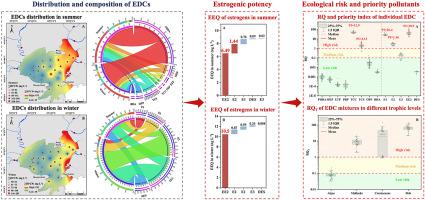当前位置:
X-MOL 学术
›
Environ. Pollut.
›
论文详情
Our official English website, www.x-mol.net, welcomes your
feedback! (Note: you will need to create a separate account there.)
Endocrine-disrupting chemicals in a typical urbanized bay of Yellow Sea, China: Distribution, risk assessment, and identification of priority pollutants
Environmental Pollution ( IF 7.6 ) Pub Date : 2021-06-16 , DOI: 10.1016/j.envpol.2021.117588 Shuang Lu 1 , Chunye Lin 1 , Kai Lei 2 , Ming Xin 3 , Baodong Wang 3 , Wei Ouyang 4 , Xitao Liu 1 , Mengchang He 1
Environmental Pollution ( IF 7.6 ) Pub Date : 2021-06-16 , DOI: 10.1016/j.envpol.2021.117588 Shuang Lu 1 , Chunye Lin 1 , Kai Lei 2 , Ming Xin 3 , Baodong Wang 3 , Wei Ouyang 4 , Xitao Liu 1 , Mengchang He 1
Affiliation

|
Endocrine-disrupting chemicals (EDCs) in water are receiving particular attention as they pose adverse effects on aquatic systems, even at trace concentrations. A comprehensive study was conducted on 14 EDCs (five estrogens and nine household and personal care products (HPCPs)) in the water of the urbanized Jiaozhou Bay in the Yellow Sea during summer and winter. Results showed that the total concentration of 14 EDCs ranged from 100 to 658 ng L and 56.7–212 ng L in the estuarine and bay water, respectively. The average total concentration of five estrogens in summer was significantly ( < 0.05) lower than that in winter due to the higher precipitation dilution and degradations during summer, whereas the average total concentration of nine HPCPs was significantly ( < 0.05) higher during the summer than that during the winter because of the higher usage and emissions during the summer. Estrogens and HPCPs were dominated by 17α-ethinylestradiol and p-hydroxybenzoic acid (PHBA), respectively. High PHBA concentrations may be related to the hydrolysis of parabens. The total concentrations of EDCs were higher in the eastern coastal seawater of the bay due to the strong influence of domestic and industrial wastewater discharge. Estrogens may interfere with the endocrine system of aquatic organisms in the bay because the total estradiol equivalent concentration exceeded 1 ng L. 17α-ethinylestradiol was the main contributor to the estrogenic activity. The EDC mixtures posed high risks (RQ > 1) to mollusks, crustaceans, and fish, and low to moderate risks (RQ < 1) to algae. Fish was the most sensitive aquatic taxon to the EDC mixtures. Given the concentration and frequency of EDCs, the optimized risk quotient method revealed that 17α-ethinylestradiol, estrone, triclocarban, triclosan, and 17β-estradiol should be prioritized in ecological management because of their high risks (prioritization index of >1).
更新日期:2021-06-16











































 京公网安备 11010802027423号
京公网安备 11010802027423号